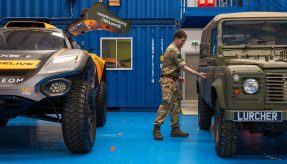
US Air Force Cadets have won a patent for support gear designed to help troops safely travel from aircraft to the ground with heavy equipment.
Air Cadets completing mechanical and systems engineering degrees in 2016 were given the challenge of designing support gear to help airmen and women from hovering aircraft to the ground while carrying heavy equipment. The Auto Belay Insertion System they invented has now been awarded three patents from the U.S Patent and Trademark Office.
The project was part of an annual Air Force Research Laboratory University Design Challenge. Each service academy and a dozen civilian universities for that iteration were charged to improve current troop insertion methods which primarily use the Fast Rope Insertion Extraction System.
Miranda Bray, a 2016 graduate and F-15E Strike Eagle student pilot at Seymour Johnson Air Force Base, North Carolina said: “This project taught me several things including that the process of creating something new is not linear, and you often have to go back to the drawing board, and the user is the most important customer. As an aircrew member, I’ve seen so many examples of good and bad human factors engineering and the research we did for this project with the Air Force Special Operations Command operators and aircrew was what made this system stand out against the competition”
There were two main issues with the current system, heavily loaded operators were struggling to brake when fast roping and their gloves were getting too hot from gripping the rope to slow down. The Auto Belay Insertion System allows operators to engage a one-handed brake without compromising rapid descent and emergency detachment from the rope in hostile environments.
Teams also no longer have to recover large amounts of the rope during training exercises. The Center for Technology, Research and Commercialization, a non-profit organisation that builds reciprocal relationships between government design agencies and commercial entities is currently looking for additional ways to use the patented technology, including for workers on oil rigs or cell phone towers.
If you would like to join our community and read more articles like this then please click here.
air safety aircraft engineering Innovation Universities US Air Force US Air Force Research Laboratory







